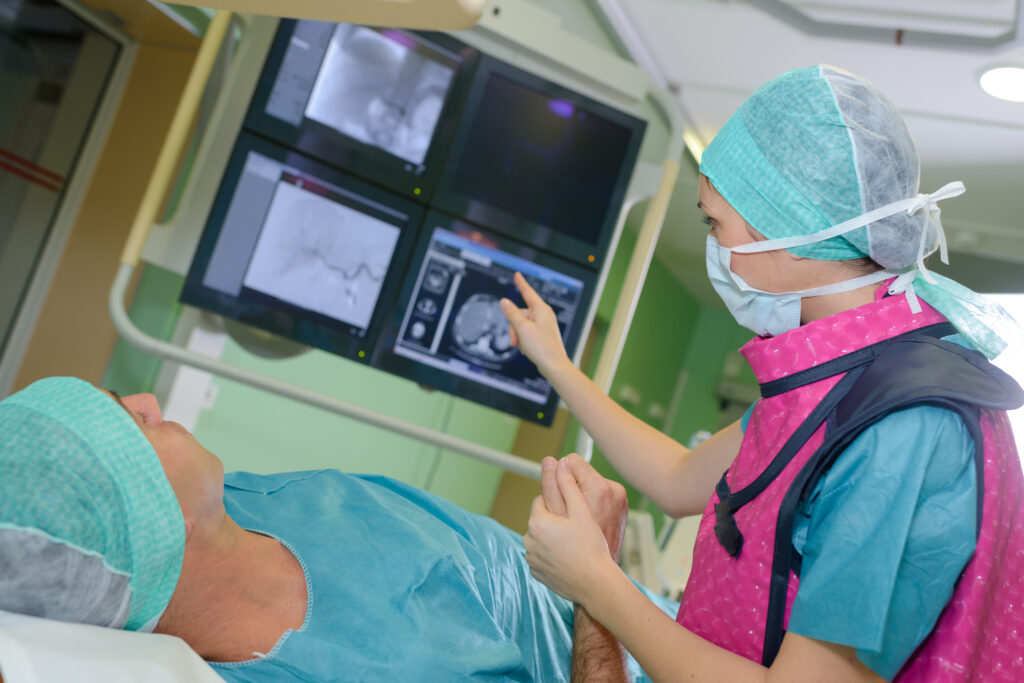About Radiology Physician Extenders
Radiology Physician Extenders (RPEs), also called Radiologist Assistants (RAs), enhance patient care by extending the capacity of the radiologist in the diagnostic imaging environment. The RA performs patient assessment, patient management, fluoroscopy, and other radiology procedures.
An RA must be an ARRT-certified radiographer who has successfully completed an advanced academic program encompassing a nationally recognized radiologist assistant curriculum and a radiologist-directed clinical preceptorship (Advanced Practice Advisory Panel, 2002).
RAs are certified as Radiology Practitioner Assistants (RPAs) through the Certification Board for Radiology Practitioner Assistants (CBRPA) or as Registered Radiologist Assistants (R.R.A.s) through the American Registry of Radiologic Technologists (ARRT).
What is a Radiologist Assistant?
A Radiologist Assistant (RA) is an advanced practice radiologic technologist certified by either the American Registry of Radiologic Technologists as an Registered Radiologist Assistant (R.R.A.) or the Certification Board for Radiology Practitioner Assistants as Radiology Practitioner Assistant (RPA).
The RA work as part of the radiologist-led team to by performing diagnostic and therapeutic imaging procedures, providing initial observations only to the radiologist, and providing technical and procedural support.
RAs play an essential role in bridging the gap between technologists and radiologists, improving patient access to imaging services, and contributing to an efficient, patient-centered health care environment.
What can an Radiologist Assistant do?
Key responsibilities of a Radiologist Assistant (RA) include:
- Perform Patient Assessments: RAs conduct focused and initial assessments to gather patient history and to understand imaging needs.
- Perform Imaging Procedures as Part of the Radiologist-led Team: RAs assist and/or perform non-invasive and minimally invasive advanced imaging procedures.
- Communicate: Along with communicating with other members of the health care team, RAs provide observations of the procedures they perform for the radiologist’s review. RAs do not make official interpretations of any imaging study.
- Quality Control and Patient Safety: RAs ensure imaging procedures comply with safety standards and maintain high-quality control practices.
What are the education requirements for Radiologist Assistants?
Radiologist Assistants have completed an advanced education program recognized by the American Registry of Radiologic Technologists (ARRT). Applicants to these programs must be radiologic technologists certified in radiography (RT(R)), obtained a bachelor's degree, and at least 2 years experience in medical imaging.
All RA programs follow the American Society of Radiologic Technologists' (ASRT) RA curriculum and all are Master's degree programs. Clinical rotations are performed under the supervision of a radiologist preceptor.
Which educational institutions offer the Radiologist Assistant Program?
What tasks are RAs prohibited from performing?
RAs must work under the supervision of a radiologist
May not interpret medical images
May not prescribe medications or therapy
How many RAs are in the U.S. and where are RAs working?
RAs are licensed or recognized in 37 states.
For specific state licensure, please see the ASRT's States that Regulate page.
RAs work in a variety of healthcare settings, often in environments where radiology services are in high demand. Common workplaces for RAs include:
- Hospitals: Many RAs work in large hospital systems, assisting radiologists in managing the heavy imaging workloads typical in inpatient, outpatient, emergency, and trauma care. They support both diagnostic and interventional radiology departments.
- Outpatient Imaging Centers: In these centers, RAs perform imaging procedures, assess patient conditions, and facilitate efficient care in settings focused on outpatient diagnostic services like MRI, CT, ultrasound, and X-ray.
- Academic Medical Centers: Academic hospitals often employ RAs to help with clinical and procedural needs while also providing training support for residents and technologists. RAs can be instrumental in teaching and supporting clinical education for radiologic technologists.
- Specialty Clinics: RAs may work in clinics with imaging support services, such as oncology, orthopedics, or vascular access or dialysis centers, where imaging plays a role in patient care. Under the radiologist's supervision, RAs often perform targeted imaging procedures specific to those specialties.
- Rural and Underserved Areas: In locations where radiologists are scarce, RAs provide a link in patient care by helping to bridge the gap, ensuring timely imaging and preliminary assessments that can expedite the radiologists’ diagnostic process.
There are 629 RAs in the U.S., and its territories!
Hover over the state to see the number of RAs.
Purpose of the Society of Radiology Physician Extenders (SRPE)
The purpose of this Society shall be to advance the profession of mid-level radiology, to assist in maintaining high standards of education and training, to elevate the quality of patient care, and to improve the public awareness of advanced radiology professionals through federal and state advocacy. These purposes shall not be restricted by any consideration of nationality, race, color, gender, sexual orientation, disability, religion, or creed.
Functions of the SRPE
- Organize meetings to advance the Society’s business, present scientific research, provide education, discuss professional issues, and encourage similar initiatives among affiliated organizations.
- Communicate information relevant the Society and the advanced practice radiology profession.
- Promote and implement high standards in education and training through educational opportunities for advanced radiology professionals.
- Support research to improve patient care, the advanced practice radiology profession, and best practices in medical imaging.
- Collaborate with external organizations to foster the Society’s and members’ professional growth.
- Advocate and promote the Registered Radiologist Assistant (RRA) and Radiology Practitioner Assistant (RPA) on matters of professional recognition, licensure, and career development.





